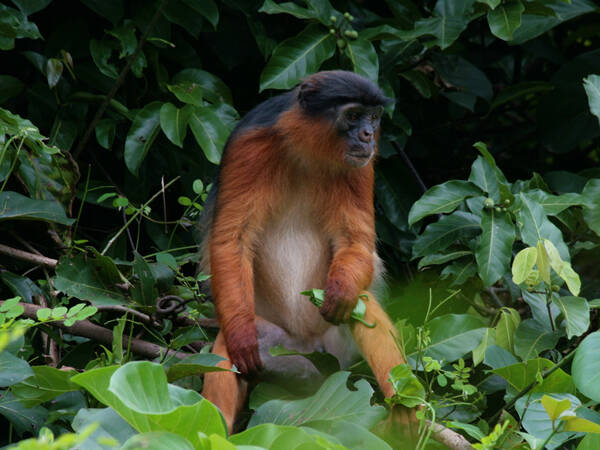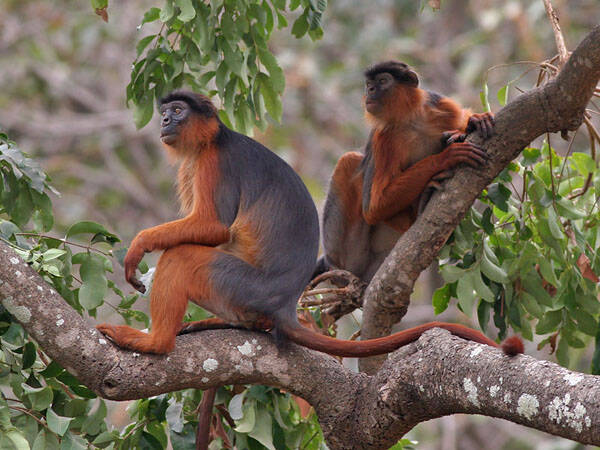Piliocolobus badius
IUCN
LCBasic Information
Scientific classification
- name:Piliocolobus badius
- Scientific Name:Piliocolobus badius,Western Red Colobus、Red Colobus,Western red colobus, West African red colobus, Bay colobus, Western red colobus, Red colobus
- Outline:Primates
- Family:Monkeys species
Vital signs
- length:45-67cm
- Weight:6.8-12.2kg
- lifetime:No verification information
Feature
Brown, gray, or black body with chestnut or red head and appendages
Distribution and Habitat
Origin: Côte d'Ivoire, Guinea, Liberia and Sierra Leone.
The West African Red Colobus inhabits all levels of the canopy from the ground to the fifth natural forest level. That is, the tops of growing trees more than 40 meters above the ground. The West African Red Colobus is found in all levels of the canopy in ancient rainforests. Most of the species live in the third or fourth layers (20-30 meters). The Senegal subspecies is found in mountain forests and tropical rainforests, and is also adapted to the dry forests of Senegal. The Ivorian subspecies lives in dense and tall forest canopies.
Appearance
The West African Red Colobus is sexually dimorphic, with adult females slightly smaller than adult males. Males weigh 9.1-12.2 kg, females weigh 6.8-9.1 kg; body length 45-67 cm, tail length 52-80 cm. The body is slender. Like other colobus species, the anal warts are small, the tail is long, and the cheek pouches are smaller than those of ordinary monkeys. They are distinguished from leaf monkeys by the lack of a thumb, although the other fingers are particularly long, and the thumb has degenerated into a small wart, hence the name colobus. The long fingers are used to grasp branches.
The body of this species is brown, gray or black, with a chestnut or red head and appendages. The pubic area is surrounded by white fur. The West African Red Colobus differs from other species of the same genus in that the whole body is covered with long hair and has no tufts. Although the size and coloration of the subspecies vary, the bright colors are attractive. The head, upper body, arms and legs
Details
West African Red Colobus (scientific name: Piliocolobus badius) is also known as Western Red Colobus or Red Colobus in foreign languages. There are two subspecies of West African Red Colobus, namely the nominate subspecies and the Senegal subspecies. These subspecies have slightly different appearances. The forehead and thighs of the nominate subspecies are black, and there is a very obvious pad on the outside of the nose. The thighs and forehead of the Senegal subspecies are more red than those of the nominate subspecies.

The West African red colobus monkey population has a strong sense of territory. The Senegal subspecies has a territory of 0.089-0.22 square kilometers, while the nominate subspecies has a territory of more than 1 square kilometer.
The West African Red Colobus is a highly arboreal primate that is diurnal. It mainly moves and lives in the high canopy (26-40 meters), and only rarely comes down to the forest floor. However, if it encounters the Diana monkey, it will come down to the forest floor. This species uses its finger bones and the swing of its tail to balance itself in the trees. It moves quickly among the trees. It gathers in groups of more than 20, which are composed of males and females and young monkeys of various sizes. Females will move from one group to another, while males remain in their natal group or leave to form a group of young males of their own. The group structure of the Senegal subspecies is loose, and often merges or splits.
The West African Red Colobus uses vocalization to communicate. When predators, such as chimpanzees and leopards, approach them, they will roar and stop shortly after the exclamation. Then, they will quickly jump up the tree, moving up 4-5 meters, or up to 26 meters or even higher.
West African red colobus monkeys are leaf eaters and are completely vegetarian. The main food includes leaves, fruits and flowers of Terminalia macroptera, Celtis integrifolia, Erythrophleum guineense, Pterocarpus erinaceus and Dichrostachys glomerata, as well as young branches. The stomach structure of this species is complex and has a unique digestive system. Their multi-chambered stomach, like that of ruminants, can digest cellulose and has been adapted to digest leaves. They eat a large amount of leaves every day, occasionally eating fruits, mosses and seeds, and the daily food intake can reach 2-3 kg. They also eat soil and charcoal to help digest the toxins in the leaves.

West African red colobus females can choose the males they mate with, as females can migrate in small groups. It is not certain whether this species is monogamous or polyandrous. Females leave their original group when they mature and join other groups, while males form single-sex groups. Males from different alliances show aggression and fight for the right to mate. When females are ready to mate, their genitals swell and turn pink. Female West African red colobus monkeys can give birth to a baby monkey every two years. The mortality rate of infants is about 30% in the first 6 months; between 6-12 months, the mortality rate is 18%; due to predation by chimpanzees, the mortality rate between 18-24 months of age is 28%. Because females migrate between groups and males do not, the mortality rate of females is higher than that of males. The lifespan of West African red colobus monkeys is unknown.
There is little information about the reproduction of West African red colobus monkeys because they do not live long enough to reproduce in captivity, and few studies have focused on this aspect in the wild. General observations indicate that after the birth of the baby monkeys, mothers will protect, care for, and raise their offspring.
West African red colobus monkeys are an important part of the bushmeat trade. It is also difficult to enforce the law in national parks, where poachers hunt with little interference. The Ivorian subspecies is either extinct or close to extinction due to poaching and the bushmeat trade. The nominate subspecies is also hunted for its long fur and beautiful color.
Listed in the IUCN Red List of Threatened Species 2017 ver 3.1 - Endangered (EN).
Protect wildlife and eliminate bushmeat.
Maintaining ecological balance is everyone's responsibility!








